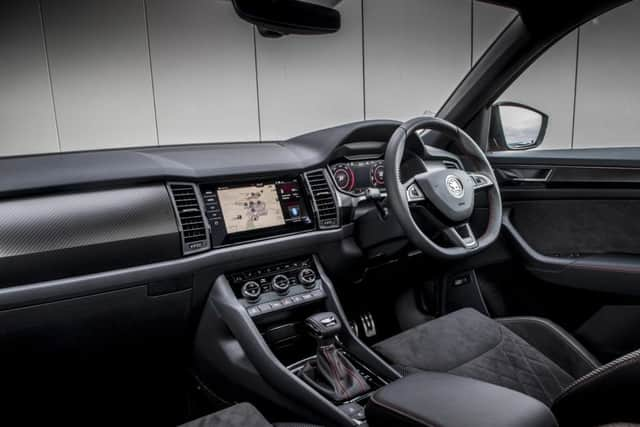Skoda Kodiaq vRS - power to the people


I've been a fan of the Skoda Kodiaq since the big family SUV was launched.
Its blend of useful space, generous equipment and range of powertrains means it's a strong choice for families looking for large-ish SUV.
Advertisement
Hide AdAdvertisement
Hide AdIt's also now a good choice for anyone who thinks their family SUV needs 20-inch wheels, twin-turbos and a tonne of Alcantara, thanks to the vRS edition.
Previously the vRS treatment has been reserved for the brand’s Fabia and Octavia hatchbacks but now the sensible, seven-seat family SUV has been given the performance treatment.


At its heart is - shock horror - a 2.0-litre diesel engine. But unlike other Kodiaqs, this one has two turbos and has been tuned to offer a healthy 237bhp and 369lb/ft - the most powerful Skoda diesel ever. It’s linked to a seven-speed gearbox and four-wheel drive system and is good for a seven-second 0-62mph time and a top speed of 136mph.
That enables it to claim the completely meaningless title of fastest seven-seater round the Nurburgring.
Advertisement
Hide AdAdvertisement
Hide AdOn normal roads, the 0-62mph time means it’ll keep up with plenty of mid-range hot hatches yet it doesn’t feel that rapid from the driver’s seat.
In that way it’s quite like the Octavia vRS which feels quick rather than properly fast a lot of the time. Some cars feel lively and fast even when you’re just pootling along. The Kodiaq is the opposite, you have to be really going before it starts to feel engaging.
Skoda Kodiaq vRS
- Price: From £45,740
- Engine: 2.0-litre, four-cylinder, biturbo, diesel
- Power: 237bhp
- Torque: 369lb/ft
- Transmission: Seven-speed automatic, four-wheel-drive
- Top speed: 136mph
- 0-62mph: 7 seconds
- Economy: 35.3mpg-34mpg
- CO2 emissions: 209g/km
When your speed does build the Kodaiq feels muscular, and mid-range pull is particularly strong thanks to the torque-rich diesel engine. A special vRS mode stiffens things up through dynamic chassis control, heavier steering, sharper throttle and gearbox response. The steering has just the right weight and there's ample grip allowing you to make decent progress but there’s no escaping this car’s roots.
It’s still a tall SUV that weighs 1.8 tonnes and the body roll common to SUVs is never truly eliminated, nor is the feeling that this isn’t really a car that was built to be boy-racered.
Advertisement
Hide AdAdvertisement
Hide AdUnderneath it all, it’s also still a Kodiaq, meaning it’s a spacious, practical, comfortable seven-seater that will fulfil most families’ every need. Everything is simple to use, feels built to last and there are the same nice little touches such as the hidden umbrellas.
The vRS gets unique design cues - new bumpers, 20-inch alloys and lots of gloss black finish - on the outside and a sporty interior to make it stand out. Alcantara and leather stretch over most interior surfaces, including the excellent bucket seats and there’s contrast stitching and vRS logos aplenty.


The vRS was also the first Kodiaq to get the virtual cockpit with full digital instrument display as well as the top-end 9.2-inch media/nav system, adaptive LED headlights, dual-zone climate control and conveniences such as cruise control and keyless entry.
It’s largely the Sportline trim with added vRS baubles and that more powerful engine.
Advertisement
Hide AdAdvertisement
Hide AdAnd that’s what leaves me torn over the Kodiaq vRS. There’s nothing to dislike about it - it does everything every Kodiaq does and chucks in a load more power - but I’m not convinced it’s necessary or special enough to command the £5,000 premium over a 187bhp Sportline.
This article first appeared on The Scotsman